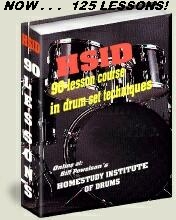* THE TYPICAL DAILY ROUTINE *
THE TYPICAL LESSON:
(This is what you'll be doing routinely, day after day, student after student . . .)
You will eventually need the ability to do every thing in super slow motion . . . and break all the moves into tiny baby steps for your students. The trick is to find the students 'learning speed' then move at that pace. If you move too fast you will lose them, and if you move too slow . . . you will bore them to tears. Every student will be different.
Yes! I know! Sometimes it's really hard to think and play slow, especially when it comes to certain techniques that only sound correct when they're played rapidly.
Don't worry too much if you have some trouble slowing things down for your students. I remember having those troubles too, in the early days. It gets easier as time goes by. Do the best you can, and BS your way through the rest, haha. That's what I've always done! (Did I mention I have a BS degree in BS, haha!)
Let's start with an average student on an average day, just to see what life as a drum teacher, is like . . .
The student shows up, (that's a plus), and after a few seconds of small talk, you head for the drum set, and begin . . .
Much of the time, I don't even sit at the kit, or play the lesson material beforehand. Sometimes, doing this only intimidates the student anyway. They want to play! They've paid for the lesson and THEY prefer to be on the set. Often, if we teachers play too much, it's like we're showing-off. It intimidates the student. It can be discouraging factor for them. We never want to discourage a student. It counters the students potential productivity. Besides, we've haven't decided what today's lesson will be, yet. Usually, it's best to seat the student at the kit, and you'll want to be in a chair next to the student.
Usually on (almost) all but the very first lesson, I seat the student at the kit immediately . . . then we spend a few minutes rehashing the previous lesson. I check to be sure they understood and practiced, at least a little during the previous week. Sometimes we may try the previous lesson material WITH A SONG, if the student seems to need help in that area.
Even if they say they've got it, it's usually best to throw a song onto the CD and give it a test run. If they are having any trouble at all, I may get on the set and demonstrate it, pointing to any clues that may not have surfaced, during the last lesson. I encourage them to USE the new technique at every opportunity when playing along with their own recordings.
With that behind us, I will often ask if there is anything special they might like to learn. If they have any ideas at all, I will usually try to run with their special interests. If they draw a blank, my next move will be to help them decide, by assessing their current knowledge against the next most important morsels of knowledge they might enjoy and appreciate.
Remember: We're working our way through all the lessons of my 125 lesson course, but . . . with the students special interests in mind. Most of the lessons can be studied in any order. Whatever the student WANTS to learn, is usually the BEST lesson to teach.
Sometimes I'll ask if they would rather tackle a beat or roll (ie; fill) pattern. I let them choose their poison! It's just good business. If they want a new fill, I may jump on the set and demonstrate several that we could tackle as lesson material. Or, if they would rather study a new beat, I'll run through any number of beats or beat variations that we could study, depending on their wishes. Again . . . I get them to choose.
Once we decide what their next lesson should be, I get them doing the easiest part of the pattern first.
If it's a fill, we start with the half bar version first. I have them play the fill SLOWLY a few times by itself. Then we connect it to the beat and repeat, repeat, repeat, the full cycle until they can do it fast enough to make it connect in-time with a slow song on a CD.
If it's a beat, we usually start with the cymbal line . . . then we add the bass part . . . I let them repeat this a few minutes until they are confident, then we add the snare part in concert with the rest. In essence, I trick them into playing the exercise, before they have a chance to offer any negative feedback. I usually DON'T show it to them in notation form, until I have them playing it.
Before they have time to say "No, I can't" . . . I usually have already coaxed them into doing it. No matter how slowly we have to take it, I continue to coax them to repeat, repeat, repeat . . . until they have the basic moves entrenched pretty well in their mind. Then . . . I back away slowly . . . and make a mad dash for the door, haha!
WELL . . . Not quite like that . . . but I do try to at least stop my constant babbling for a few minutes, and give them time to think for themselves.
.............................................................
TIP:
If you keep a computer & printer close to your teaching studio, you can print off my prepared lessons while your students practice. Once they can play the exercise, it is best to then show them how that exercise looks in notation form, on paper. You'll want them to take the paper home and practice with it all week.
This helps the student learn to read in an almost subliminal way. It works! And it works without frustration or wasted time. (More on this in a minute . . .)
.............................................................
THEN WE PROCEED . . .
Usually I get the student to a point where they can repeat an exercise very slowly, then I exit the room and let them go at it on their own for a few minutes. Most, of the time I stand just outside the door and listen. This is how I can tell if the student understands the exercise well enough to take it home and practice all week, on their own. If they sound lost, I may pop my head back in and get them going again, and again, and again, . . . until I know they are on track.
Next, I hand them the written lesson in printed notation form and explain graphically how the notation is used to serve mainly as a reminder. It is human nature to forget! The notation is used to help jog the memory 24 hours later when all seems lost.
The student is learning to read, but the focus isn't on reading. The focus is on using notation as a reminder. It reminds them how to have fun playing from memory. This is quite different than sight-reading line after line, of rhythm notation. Those type notation methods usually lead nowhere and end up sounding mechanical and uncreative, at best.
As far as I'm concerned (and I believe this totally); Too much notation can be a curse to the students progress! The student becomes like robot and totally dependant on the written music. I hate those methods. I feel they frustrate more 'real drummers' than they help. If a drummer doesn't learn to play by ear and the seat-of-their-pants, they'll most likely NEVER find their way into the profession. These days, we tend to play by 'feel' 99% of the time. It's a VERY rare day to have anyone throw a page of sheet music in front of us, wanting us to sight-read it as we play. Those days pretty well disappeared with Guy Lombardo and Lawrence Welk.
At any rate I have the student read the exercise and play it at the same time. If they prove they can do that . . . the rest is up to them. From then on it is a matter of practice, practice, practice and repeat, repeat, repeat.
A FEW MORE WORDS ABOUT NOTATION . . .
I don't believe notation was designed for PLAYING most music. I believe it was designed to help teachers illustrate in graphic, visual ways, the aural abstractions they are trying to explain.
I guess notation serves BOTH ends in the long run. But, I feel that if the instructor over-stresses written notation, it may often tend to frustrate the MOST TALENTED and MOST CREATIVE students. Too much music notation can easily become more destructive than constructive. It stifles the natural creative flow! The students who balk at written notation are often the very same students who'll usually go on to become the VERY BEST professionals! They are the creative artists!
Notation, to most creative types, lacks 'individual expression'. 'Individual expression' is the thing that makes music, fun.
Notation, to creative types is very often like painting by the numbers! It tends to be SLOW, BORING, and FRUSTRATING! So . . . If you are one who seems to have trouble with written notation, don't worry yourself too much about it. You're probably destined to do well! It means that you probably lean more towards creative imagination. That's a GOOD thing, and not a bad thing.
Sure! It is IMPORTANT to learn to read. Your students WILL learn to read FASTER with this method. The difference is, MOST of the focus is placed on 'individual expression', 'jamming' and 'ear playing', in the beginning stages, like it should be, . . . READING IS SECONDARY TO THE PROJECT OF LEARNING TO PLAY.
As a result, I try to keep the notation studies simple & easy until the student is happily jamming by 'ear' with everything on the radio. By that time they'll know for sure that drumming will forever be a part of their lives. It is then that we can inject the dry, boring stuff, a little at a time. Usually, by then they are eager to learn all they can, EVEN the dry, boring material. Then they discover the really good news. If they've mastered the note-value (rudimental) fills, it means they virtually mastered note-values without a lot of boring, frustrating, pain.
NOTATION BY LOGIC AND SUBLIMATION . . .
My course is designed to teach note values in a somewhat subliminal way. By the time a student learns what 16th notes really are and what they look like in note form, he/she is already an old hand at playing them. This tends to eliminate, or at least simplify, most of the boring (note value) math and memorization that goes with other methods of instruction.
Again, even though I have the 'Note Value Lesson' close to the top in the web pages, I usually skip that lesson, until after we've mastered the note-value fills . . . Then, the student can usually whip through all the note values, symbols, rests, and all that, in 15 minutes or less. They'll discover that they've already learned it, and they're still onboard and happy.
REMEMBER ALWAYS: The quicker the student sees results, the more loyal they will be as students. It is a form of job security for us.
ANOTHER IMPORTANT TEACHING TIP/TOOL:
Always have a good supply of recorded music on hand as you teach. Everything in this course should be adapted to music as soon as the student can repeat the patterns quickly enough to use them in a SLOW song. A very large portion of your lesson-time can and SHOULD be spent playing along with recordings. This helps the time literally seem to fly by, for both you and the student. The student will leave happier, and more confident, and so will you.
I always encourage (often beg) my students to bring their own favorite recordings to class. Very often, we'll start by LISTENING to their music, then I'll find a lesson that relates to something on one of their CDS. This usually thrills the students beyond words. Try it!
In most cases I have music recordings handy in the studio . . . I try to select music the students can appreciate and relate to. I don't pick and choose songs according to MY taste . . . I lean into the students taste, whenever possible. It's just smart to do that.
As soon as the student can maintain and repeat the drum lesson exercise for a reasonable length of time at a reasonable tempo, we do the same exercise with recorded music . . . the STUDENTS FAVORITE CHOICE of course. Normally a student will light up like a Christmas tree the moment they discover how easy it is to actually jam a new idea, into the music they instinctively love.
If they have problems and seem frustrated, it is best to simply stop and tell them you were expecting it to be a little tough. Don't allow any lesson to become a painful experience for them. SELF DOUBT IS A KILLER! Back up and slow down at the first sign of frustration. Next, assure them that if they will practice the exercise faithfully for a week, it will all come natural and easy, by the next lesson. Usually, it does.
With each new idea or technique we teach, it's good to be sure the student learns to listen for 'that' specific technique in their own favorite songs. If they can hear it being done in a hot new favorite song, they will usually come back doing it . . . That is, IF they are determined to learn, and IF they are destined to become a drummer.
That's it! What you've read above is the daily routine. Send student#1 on home with their written lesson in hand, to practice for a week.
Call in the next student and start the process all over again.
In the next lesson, we'll tackle the DIFFICULT STUDENT TYPES. The trick is to, win them over and keep them returning every week.
Finite To Infinity
3 very important questions
IS IT POSSIBLE THAT YOUR 'NATURAL GIFT' OF RHYTHM CAN BE DOUBLED WITH ONLY A LITTLE ADDITIONAL (PREVIOUSLY UNAVAILABLE), KNOWLEDGE?
IS THERE A 'KNOWLEDGE GAP' IN YOUR OWN UNDERSTANDING OF 'RHYTHM'?
IS IT POSSIBLE TO GAIN A COMPLETE AND THOROUGH UNDERSTANDING OF 'ALL RHYTHM', WITHIN ONLY A COUPLE HOURS OF EASY, AND FASCINATING, STUDY ?
Answers: YES! YES! YES!
Get All Products Here

GET ALL THE PRODUCTS AT ONE LOW PRICE.
SURPRISES ABOUND!!!! . . . For those with a bit of generosity in their soul.
CLICK HERE , to see what I mean.
Intermediate & Advanced Drummers
- Drum Instructors Wanted
- Teach My Lessons and Methods
- Up to $60.00/hour
Pre-School Drummer?
Can we teach rhythm to pre-schoolers? YES!
This is a very short course, designed to help adults plant the seeds of rhythm into children of nearly any age. Click Here!!
Make CASH $$$ Now!!!

FREE ELECTRONIC BOOK BONUS (also included) BUSINESS OPPORTUNITY:
- * MAKE BIG MONEY SELLING USED DRUMSETS!
- * INSIDER HARDBALL-BUYING-TIPS AND SECRETS.
- * UNIQUE RECOVERING SECRETS
Support Us Today!!
Support this site and and gain an advetising bargain with the deal. Place a permanent ad here.
